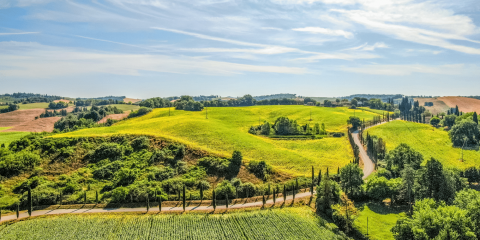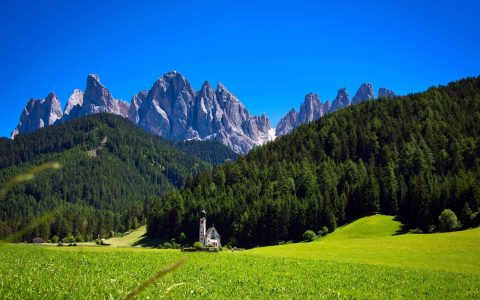Vines 101:
Sicilian Wine
Gone are the days when Sicilian wine was shipped en masse northwards to lend its sun-soaked alcohol levels to anonymous table wines. Sicily is back, baby, and once again starting to live up to its historic potential.
Archaeology reveals that Sicily has been growing grapes and making wine since at least 2000 B.C., and the winemaking methods continue to improve with each ruling dynasty. We know that the Sicilian Greeks had a game called kottabos, where they would try to throw wine from a glass to a bowl on the other side of the room without spilling any. The Romans claimed that Sicilian wines were a favourite of Julius Caesar, and that he served them at all important banquets. However, it was the Normans who really perfected the art of making wine.
Today, Sicily ranks third in Italy for wine production, boasting 20 DOC (Denominazione di Origine Controllata) wines, denoting careful quality controls and typicity. The province of Trapani (including Marsala and Mazara del Vallo) alone claims 45% of all of Sicily’s vineyards. To try to make sense of Sicily’s bewildering variety of wines, below are some of their most important autochthonous varietals, or grapes that have evolved for millennia on the island, and some of our favourite DOC regions. International varietals like Syrah, Cabernet, Merlot and Chardonnay are increasingly popular, especially when blended with these local treasures.
Our advice? Try a bit of everything!
See Sicily For Yourself
Sicily has long extended a welcoming hand to visitors. On our Sicily Biking trip, the entire experience is pure indulgence for the senses: admire the island’s rich culture while you savour fresh seafood, handmade pasta and (of course) the wine.
DETAILED ITINERARYRed Sicilian Wine & Varietals

Etna DOC
Whether red, white or rosé, you know it comes from the lava slopes of eastern Sicily’s great volcano. The white is made from carricante, catarratto bianco, trebbiano and mannella Bianca; the red and rosé from nerello mascalese, nerello mantellato and nerello cappuccio. Producers to watch include Antichi Vinai, Emanuele Scammacca del Murgo, Tenuta Scillo di Valle Galfina and Barone di Villagrande.
Nerello Mascalese
This grape, the most typical varietal of Etna, is named for winemakers from the Mascali plain (squeezed between the volcano and the sea), who increased its cultivation. Often blended with Nerello Cappuccio or other grapes, it brings an intense violet nose and full, warm and dry flavour to the mix.
Frappato di Vittoria
An autochthonous red grape named for the southeastern town of Vittoria, frappato is blended with Nero d’Avola (and sometimes Grosso Nero and Nerello Mascalese) grapes to make Cerasuolo di Vittoria DOC. Intensely red with hints of violet, its flavour recalls cherries. Producers to watch: Avide, Fatascià, Feudo di Santa Teresa, Poggio di Bortolone.
Nerello Cappuccio or Mantellato
Also called Mantiddatu Niuru, this grape from the Etna region is so named (“cloaked”) for its planting style. It is most often vinified with Nerello Mascalese, its less-intense flavour, fruity notes and very gentle tannins smoothing out the blend.
Nero d’Avola
Named for the south-eastern town of Avola, this deep red grape used to be called Calabrese (from the Sicilian calavrisi, meaning “grape from Avola”) and is one of Sicily’s most important varietals. Its wines are well-structured for aging, with a deep cherry-red colour and a rich earthy nose with spice, mineral salts, and prominent red fruits. Vinified in steel tanks, it can make a fresh, fruity red when drunk young, while aging can bring it to its full potential of a harmonious, balanced, warm and dry wine worthy of great meals.
Still Thirsty?
Sicily’s vines yield more wine than one blog post can contain. Check out our round up of the island’s whites and varietals in Vines 102.
MORE FROM Italy + Sicily

Take on a Challenge on the White Roads of Tuscany
Tuscany
Reading for the Road: Books About Florence
Tuscany
New Trip Spotlight: Venice to Verona Biking
Veneto
Cuisine 102: Tuscan Delicacies
Tuscany
New Trip Spotlight: Piemonte to Portofino Walking
Cinque Terre
How to Best Experience the Natural Wonders of Umbria
Umbria
Notes from the Road: A Research Trip in Sicily
Sicily
Umbria’s 3 Essential Cities
Umbria
Sustainable Cuisine in Northern Italy: In Conversation with Michelin-starred Chef Norbert Niederkofler
Dolomites
The Origin of the Negroni: Florence’s Favourite Cocktail
Tuscany
The 10 Best Restaurants in Florence
Tuscany
Giro-E: Racing the Giro d’Italia Route on E-bikes
Italy
The Best Villas in Italy: Amalfi, Tuscany and Umbria
Amalfi Coast
A Taste of Piemonte with Silvia Altare
Piemonte
Finding Prosperity in Food & Community in Rural Italy
Puglia
5 Unmissable Tuscan Hilltop Towns
Tuscany
The Most Incredible Hikes in Italy’s Dolomite Mountains
Dolomites
The Best Hotels in Rome for Every Taste
Rome
A Day in Florence: Rediscovering the City with Family Post-Lockdown
Tuscany


